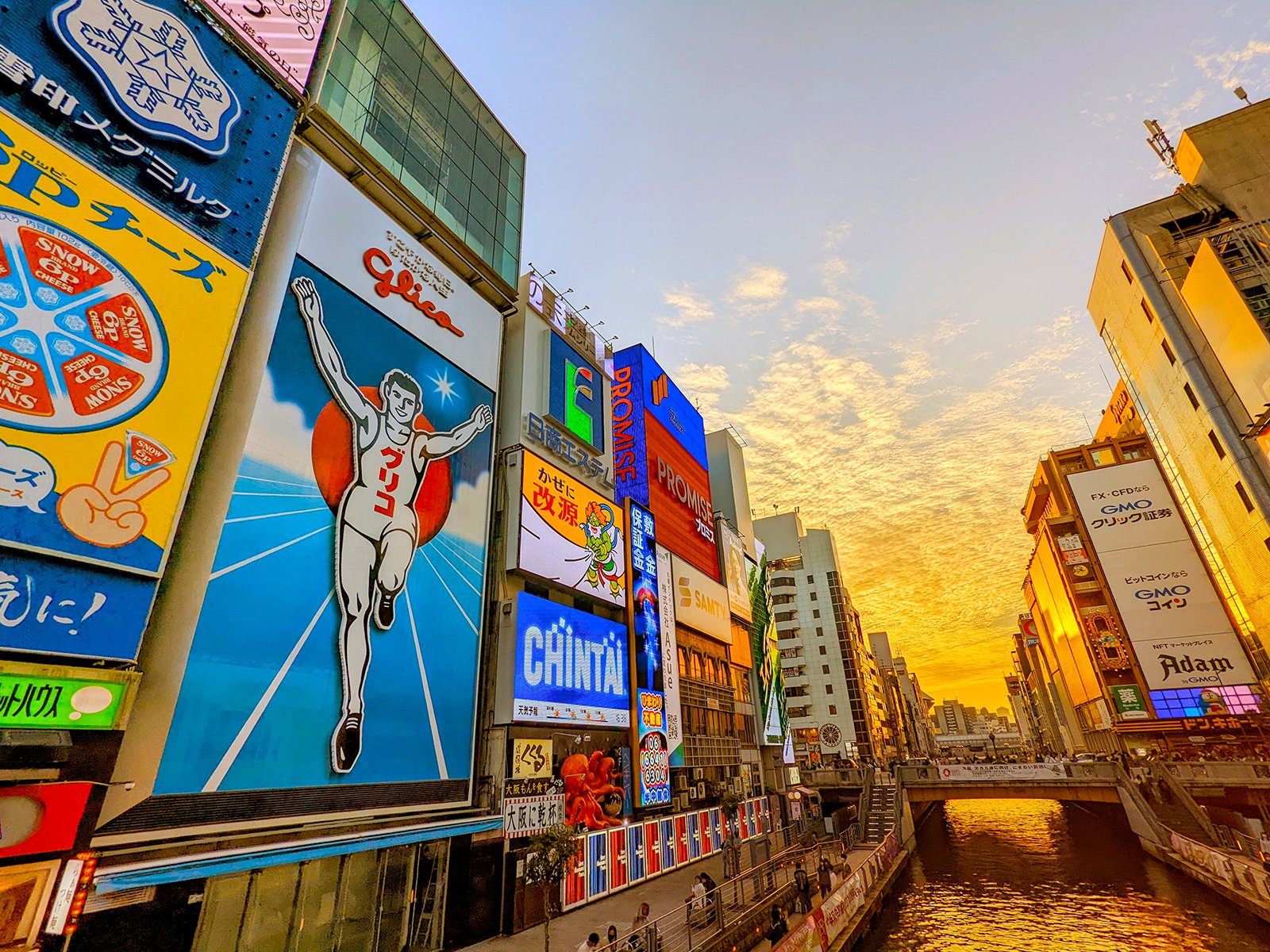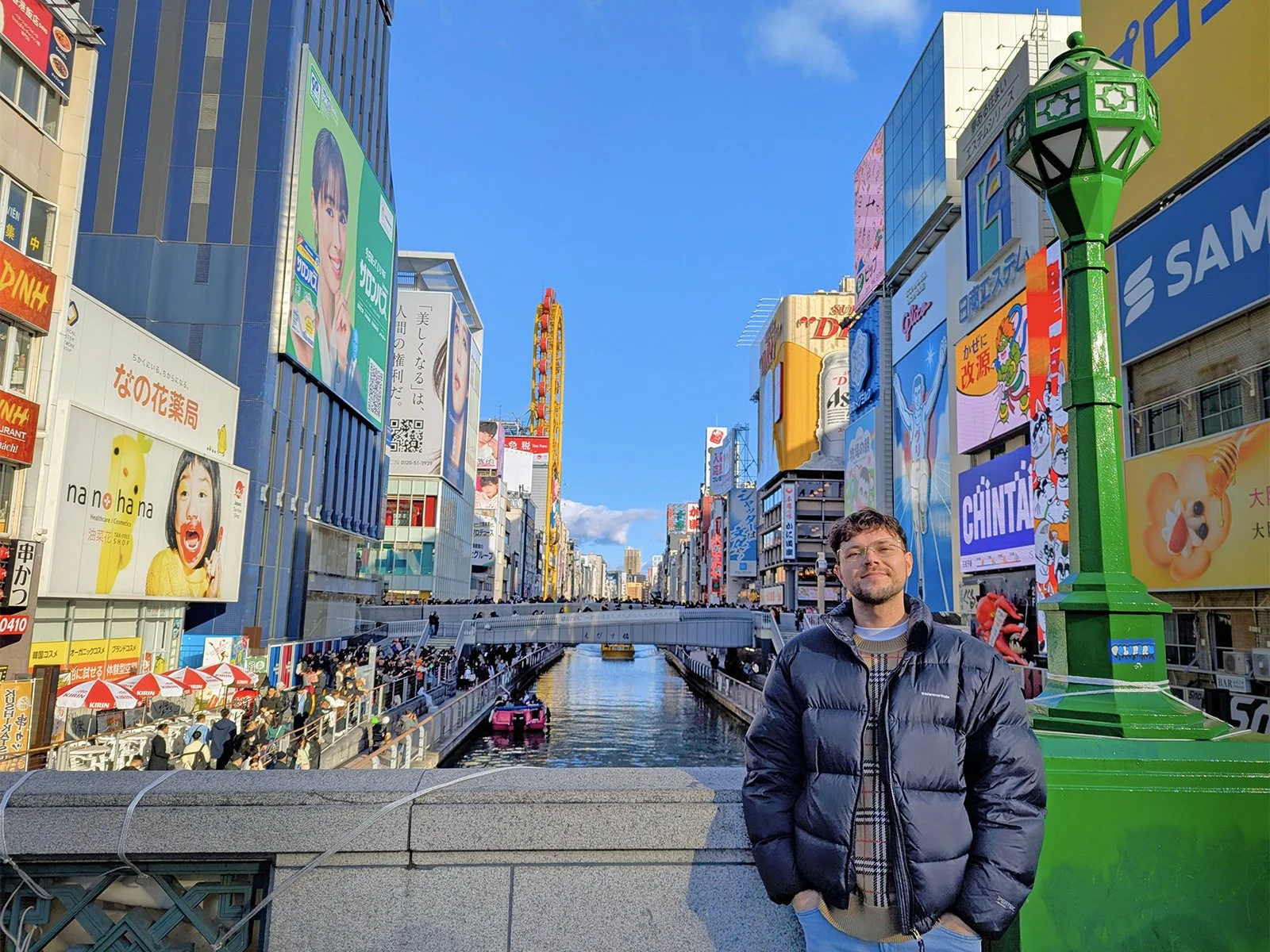A Visual History of Osaka’s Dotonbori

The entertainment district has been the heart of the city for over four hundred years.
Cover photo: Sunset over Dotonbori, Osaka, Japan (2022). Photo by Danny With Love.
Intro
From its days as a theater center to the street-food mecca it is today, Dotonbori has served as the heart of Osaka for over four hundred years. Prior to COVID-19, the district welcomed 10 million tourists annually, crowded by throngs of tourists and locals at nearly every hour.
In 1912, literary critic Yoshijiro Takasu (高須 梅渓) observed, “the atmosphere of the theaters … including banners, flags and small paper lanterns, … drinking bars, restaurants, [and] signs … arouses curiosity and sharply stimulates senses of taste and color” and Dotonbori remains as enchanting a century later.
Full of enticing sights and smells, the bustling area is magnetic. Though the river stretches just 2.7 kilometers (1.7 miles), here visitors can indulge at countless restaurants, clubs, and bars.
With some of the most extravagant storefronts in the world, Dotonbori feels like a foodie theme park, offering local specialties such as takoyaki (蛸焼) [fried octopus dumplings] and okonomiyaki (お好み焼き) [savory noodle pancakes] and kushikatsu (串カツ) [deep-fried skewers].
A visit to Osaka is simply incomplete without a trip to historic Dotonbori.
History
First known as ancient Naniwa (難波京), Osaka (大阪) was settled upon the wetlands of the Yodo-gawa Delta, fed by the river running from Lake Biwa to Osaka Bay. It’s here that daimyo (大名) [feudal lord] Hideyoshi Toyotomi (豊臣 秀吉) established Osaka Castle in the 1580s. At his order, Osaka’s first canals were dug as defensive moats, transportation arteries, and sewage drains.
According to local folklore, in 1612 a merchant-entrepreneur named Doton Yasui (安井 道頓) invested his entire savings to develop the Umezu tributary into a commercial area, but he died in the Siege of Osaka before he could see his dream realized. The Yasui family completed Doton’s plan, naming the new area Dotonbori (道頓堀), or the Doton Canal, in his memory.
Theater Street
The Dotonbori area — also rendered as Doton-bori, Dohtonbori, or Dotombori — includes both the canal and the street running parallel to the south bank. By 1625 — over a century prior to the start of New York’s Broadway — the site developed as a Theater District, home to multiple venues for entertainment.
As theater had become incredibly popular, plays were regulated by the shogunate to maintain moral standards. Box yagura (櫓) [turrets] were installed on the front of theaters to prove authorization by the ruling clan.
By the end of the 17th century, Dotonbori hosted six kabuki (歌舞伎) [song and dance] and five bunraku (文楽) [puppet] theaters, more than any other city in the empire. The great playwright Monzaemon Chikamatsu (近松 門左衛門) — called Japan’s Shakespeare — settled in Osaka and his plays premiered at Takemotoza in Dotonbori.
Chikamatsu’s classic bunraku plays Sonezaki Shinju (曾根崎心中) [The Love Suicides at Sonezaki] and Kokusen’ya Kassen (国性爺合戦) [The Battles of Coxinga] are still performed today.
Food
In Dotonbori, restaurants, teahouses, and hotels developed to accommodate the growing numbers of theater patrons. Some 90% of the city’s 350,000 residents were merchants and artisans.
As a transportation hub blessed with abundant resources from the nearby sea and mountains, Osaka — “The Large Hill” — has long held a reputation as the culinary capital of Japan. Since the Edo Period, it was referred to as “tenka no daitokoro” (天下の台所) or “the kitchen of the nation.”
Locals repeated, “Kyo no kidaore, Osaka no kuidaore” (京の着倒れ、大阪の食い倒れ) or “Kyoto is for shopping; Osaka’s for eating.” To be precise, the word kuidaore (食い倒れ) translates as “eat ‘til you drop” or “eat into bankruptcy.”
It’s no surprise that the world’s first commodity futures market was established here in 1697, with brokers setting the price of rice for all Japan at the Dojima Rice Exchange.
“Kyoto is for shopping;
Osaka’s for eating.”
Osaka’s famous drummer-clown mascot Kuidaore Taro (くいだおれ太郎) was born in 1950, named after the city’s gourmand lifestyle, and the iconic restaurant Kani Douraku (かに道楽) — known for its mechanized crab signage — opened in 1963.
Ebisu
Dotonbori’s most famous spot is Ebisu-bashi. In the center of this pedestrian bridge, visitors are washed in glowing lights, like Tokyo’s Shibuya Crossing or New York’s Times Square. The place is popular for photos, street-performances, and celebrations.
When the local baseball team Hanshin Tigers won the Japan Series in 1985, fans jumped into the muddy river from Ebisu-bashi. A mob even threw a statue of Colonel Sanders from a nearby KFC (Kentucky Fried Chicken) restaurant into the canal. Since then, the team’s poor performance has been attributed to “the curse of Colonel Sanders.”
First built immediately after the canal’s excavation, Ebisu-bashi is named after the Shinto kami (神) [deity] Ebisu (戎), as it sits on the pilgrimage route to Imamiya Ebisu Shrine (今宮戎神社) to the south. Ebisu is the only native kami of Japan’s Seven Lucky Gods, or Shichi-fuku-jin (七福神).
As the patron of fishermen and merchants, portly Ebisu is especially beloved in mercantile Osaka. A popular greeting among locals is “Mokari makka?” (儲かりまっか) or “[Are you] making any money?” Early January, people celebrate Ebessan (えべっさん) or Toka Ebisu (十日えびす) to pray for prosperity in the new year.
The kami also lends his name to the nearby ferris wheel, Ebisu Tower, installed into the building facade of discount retailer Don Quijote (ドン・キホーテ). Built in 2005, and reopened in 2018 after a nine-year closure, the ride is the world’s only oblong-shaped ferris wheel!
Glico Running Man
Another testament to Osaka’s culinary history is the enduring Glico Running Man sign, first installed in 1935 by the eponymous food company. Today, Osaka-based Glico (グリコ) is best known for their chocolate-coated biscuit stick brand Pocky, but their first product was a heart-shaped caramel enhanced with glycogen derived from oysters (hence the company name).
The nutritious candy boasted “Hitotsubu san-hyaku metoru” (一粒300メートル) or “300 meters in a single piece.” Packaging featured a marathon runner with his arms raised in victory, said to be inspired by Filipino athlete Fortunato Catalon, once called “Asia’s fastest man.”
Founder Riichi Ezaki (リイチ・エザキ) chose to advertise the health-conscious treat along Dotonbori, where some 200,000 people passed each day. The strategy proved a massive success, and the image of the Running Man has endured for six generations, with the latest iteration powered by light-emitting diodes (LEDs). The sign is still a popular photo-spot for locals and tourists alike, generating an incalculable amount of free advertising.
World War II
By 1930, Osaka had a population over two million, briefly surpassing even Tokyo to become the sixth largest city in the world. As a major port and one of Japan’s largest financial centers, Osaka was a prime target in World War II.
American air raids devastated Osaka throughout 1945; nearly a third of the city was destroyed, including Osaka Castle and half of the city’s homes. In total, 15,000 people were killed.
The city center was flattened, along with most of Dotonbori. A majority of lost entertainment venues were never rebuilt. Today, the only remaining historic theater is Shochikuza, celebrating a century of performances since 1923.
Water
Osaka was “launched to wealth and prominence by its Kansai-region waterways and transoceanic links,” notes journalist Chris Page. Throughout the ancient Kofun Period, the region served as the gateway to Japan from China and Korea.
Since the Edo Period, Osaka was alternatively called the city of “808 bridges” (八百八橋) the “City of Water” (水の都), and a “Venice of the East” (大阪東洋のベニス). Storehouses and fish markets lined the canals and locals crowded the waterfront to cool off during the hot summer days.
“For many people in Osaka today, the bright scene of a flourishing water capital does not exist even in their memories,” laments Takuji Kobayashi (小林 卓司), an engineer and board member of the waterfront advocacy group Mizube NPO.
After World War II, starting in the 1960s, most of Osaka’s canals were reclaimed to build some 40 miles of criss-crossing highway for the city’s three million residents. This decision is attributed to a decline in waterway traffic and deteriorated water quality.
By the year 2000, just eight passenger ferry routes were in operation, down from 31 in 1935. Today, only 10% of city land remains underwater, though many areas — such as Shinsaibashi (心斎橋), Tenmabashi (天満橋), and Yotsubashi (四つ橋) — retain the names of bridges no longer in existence, their canals filled with bombed rubble.
Dotonbori was one of few waterways spared during the city’s rapid reconstruction. The adjoining Higashi Yokobori River, is devoid of sun, completely covered by elevated highway.
By the 21st century, city officials finally recognized Osaka’s waterfronts as a public asset, embracing a series of projects to revitalize surviving canals.
Dotonbori’s Tombori (riverwalk) was completed in 2004, expanding pedestrian access to the canal with water-level boardwalks on the riverbank. Visitors can also enjoy a 20-minute canal cruise along the route.
Future
Upon my first visit to Dotonbori in 2022, I was shocked to find the area virtually deserted. Like in many places throughout the world, COVID-19 restrictions threatened the viability of local businesses, but the entertainment district is finally on the rebound.
Prior to COVID-19, Osaka — the nation’s third-largest city — was experiencing faster tourism growth than Tokyo. During this year’s Golden Week, Japan’s main holiday period, Dotonbori recovered 70% of pre-pandemic crowds.
In 2019, Osaka welcomed 12 million international visitors, a number expected to double by the end of 2030. Undoubtedly, Dotonbori will continue to evolve, offering new landmarks, signage, shops, events, and culinary options; the area’s unique charm and culture will continue to attract visitors from around the world.
With Osaka set to host World Expo 2025 on the new artificial island of Yumeshima, the national government is investing 10 billion yen (approx. 72 million USD) for the construction of canal locks — boat elevators — to restore old shipping routes.
Improved water transportation will strengthen supply chains and emergency preparedness, while additional passenger ferries will accommodate commuting residents and sight-seeing tourists alike.
As Osaka returns to its former glory, in all its historic charm, the metropolis can once again be enjoyed as a City of Water, perhaps as Doton Yasui himself experienced it.






